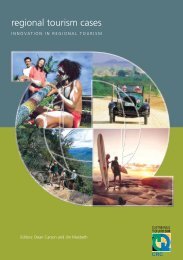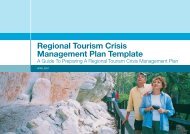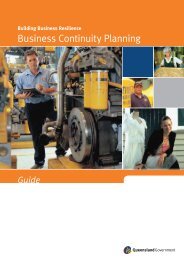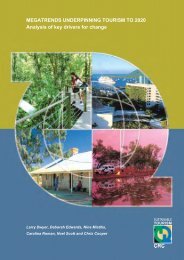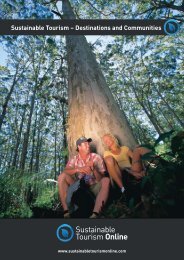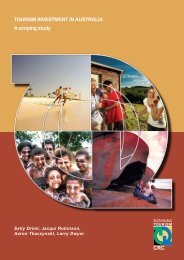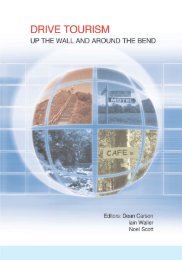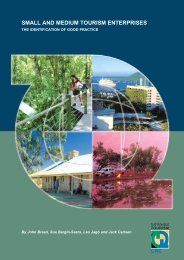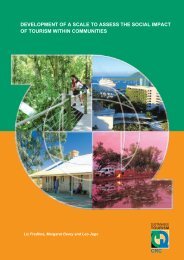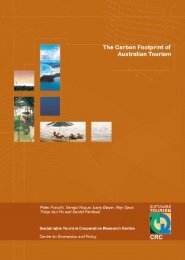Tourism Risk Management - Sustainable Tourism Online
Tourism Risk Management - Sustainable Tourism Online
Tourism Risk Management - Sustainable Tourism Online
You also want an ePaper? Increase the reach of your titles
YUMPU automatically turns print PDFs into web optimized ePapers that Google loves.
Crisis <strong>Management</strong> in <strong>Tourism</strong> in Tropical North Queensland in 2000<br />
Explanation of a cyclone<br />
Tropical cyclones (known as hurricanes in the northern hemisphere) are intense atmospheric<br />
depressions in which the winds whirl in a clockwise direction around a small, calm ‘eye’. There are<br />
five categories of cyclones, with wind speeds ranging from 63km/h to in excess of 280km/h.<br />
Tropical North Queensland (TNQ) is the main tropical region of Australia and encompasses the<br />
north-eastern corner of Australia, including vast inland areas and Cape York. TNQ is within the<br />
cyclone belt of the southern hemisphere and during the cyclone season, between November and<br />
May, cyclonic winds can destroy vegetation and property while storm surges can inundate low-lying<br />
areas causing erosion and flooding.<br />
Background<br />
When a tropical cyclone forms off the coast of TNQ it is tracked by government meteorological<br />
agencies and the media. Television stations in southern Australia, the main markets for TNQ<br />
tourism, usually use file footage of previous, destructive cyclones as background to a story of a new<br />
cyclone forming; even when the new cyclone is hundreds of kilometres out to sea and having no<br />
effects. This can cause concern to potential visitors and reduce domestic tourism numbers to TNQ.<br />
Many of the cyclones which form in the Pacific Ocean each year don’t even reach the Queensland<br />
coast.<br />
<strong>Tourism</strong> Tropical North Queensland (TTNQ) is the Regional <strong>Tourism</strong> Organization for TNQ and is<br />
responsible for destination marketing and management of tourism for the region. In 1999 TTNQ<br />
developed a crisis management plan, primarily for cyclones. Extensive consultation took place with<br />
the government agencies responsible for disaster preparedness and disaster management<br />
including the State Emergency Services Department, Police, Queensland Weather Bureau, Cairns<br />
City Council plus business groups such as the Chamber of Commerce and the Cairns and Region<br />
Economic Development Council. The purpose of the plan was not to duplicate or impinge on the<br />
official agencies’ roles and responsibilities, but to address additional elements, particularly<br />
communication to tourism markets in Australia and overseas on the situation in relation to cyclones.<br />
Another objective was to facilitate consistent and accurate reporting of the impact on tourism of any<br />
disaster in the region by the agencies and organizations dealing with the media.<br />
The plan, which was agreed to by all relevant parties, contains business and private contacts for<br />
key representatives of all agencies and organizations so that immediate communication can be<br />
initiated and actions agreed to when an event occurs.<br />
It was also agreed that in an event which had the potential to damage normal communication<br />
channels, a tourism representative would join the government agencies in their operations centre<br />
(established when a situation requires the State’s emergency services to take control from a central<br />
point, it has alternative power and communications). Thus contact could be maintained with the<br />
media and the travel industry in Australia and overseas, and accurate reports provided.<br />
Cyclone Steve<br />
On the 26 February 2000, Tropical Cyclone Steve was identified off the coast of Cairns. It quickly<br />
moved toward the North Queensland coast with increasing wind strength. By 1pm the following day<br />
it was classified as a Category 2 cyclone with winds of up to 170 km/h. Cyclone warnings were<br />
issued every hour via local media, and tourism and accommodation operators immediately<br />
implemented emergency procedures for the safety of visitors and staff. The general community was<br />
also advised to take actions to secure properties and buildings and to take precautions for personal<br />
safety.<br />
60 <strong>Tourism</strong> <strong>Risk</strong> <strong>Management</strong> – An Authoritative Guide to Managing Crises in <strong>Tourism</strong>



